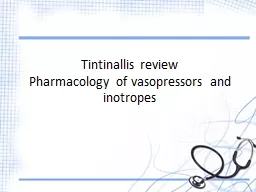

Introduction Vasopressor Increase BP amp MAP by vasoconstriction Reserved for persist hypotension after volume resuscitation Most have multiple actions on heart and vascular Some are inotropes gt improve cardiac output LVHF or cardiogenic shock ID: 912493
Download Presentation The PPT/PDF document "Tintinallis review Pharmacology of vaso..." is the property of its rightful owner. Permission is granted to download and print the materials on this web site for personal, non-commercial use only, and to display it on your personal computer provided you do not modify the materials and that you retain all copyright notices contained in the materials. By downloading content from our website, you accept the terms of this agreement.
Slide1
Tintinallis reviewPharmacology of vasopressors and inotropes
Slide2IntroductionVasopressor
Increase BP & MAP by vasoconstriction
Reserved for persist hypotension after volume resuscitation
Most have multiple actions on heart and vascular
Some are inotropes > improve cardiac output (LVHF or cardiogenic shock)
Slide3Dopamine
Endogenous catecholamine
Metabolic precursor
of norepinephrine/epinephrine
Dopaminergic, α1, β1, and β2 receptors
Dose dependent
Intermediate (5-15 mcg/kg/min) > increase renal blood flow, heart rate, cardiac contractility and
outpur
High (>15 mcg/kg/min) > α-adrenergic effect > vasoconstriction
Low > no longer recommend
Slide4Dopamine
Pharmacokinetics
Slide5Dopamine
Indications
Hemodynamically hypotension by MI, trauma, heart and renal failure with unsuccessful fluid resuscitation
Unstable bradycardia unresponsive to atropine
Not recommend as first line vasopressor in septic shock
Dosing and
administration
Slide6Slide7Dopamine
Adverse
effects
Chest pain, palpitation, ectopic beats and tachycardia
Hypotension (low doses)/Hypertension (higher doses)
Headache, N/V
Gangrene
Slide8Epinephrine
Endogenous catecholamine
Nonselective
α-
and
β-
adrenergic agonist
Increases in SVR, heart rate, cardiac output, and BP
Bronchodilator in asthma
Treatment of anaphylactic reaction
Increases cerebral and coronary perfusion during resuscitation > ACLS
Slide9Epinephrine
Pharmacokinetics
Slide10Epinephrine
Indications
Anaphylaxis/hypersensitivity reaction and acute asthmatic attack
Cardiac arrest
Symptomatic bradycardia unresponsive to atropine or pacing
Severe sepsis and septic shock
Dosing and
administration
Slide11Slide12Epinephrine
Adverse
effects
Angina, palpitations, arrhythmias, and tachycardia
Headache and N/V
Anxiety
Pulmonary edema
Tissue necrosis from extravasation (treat by local phentolamine)
Slide13NorepinephrineEndogenous catecholamine
Stimulate
α-
,
β-
adrenergic receptors (
β1 > β2)
receptors
Peripheral vasoconstriction + increase BP (
α-
)
Inotropic effect + coronary artery dilate (
β-
)
Used in sepsis/septic shock and severe hypotension refractory to fluid resuscitation
Slide14NorepinephrinePharmacokinetics
Slide15NorepinephrineIndications
Acute and profound hypotension in post-arrest
Vasopressor of choice in severe sepsis/septic shock refractory to fluid resuscitation
Dosing and administration
Slide16Norepinephrine
Slide17NorepinephrineAdverse effects
Bradycardia, arrhythmia and cardiac arrest
Hypertension, N/V, and headache
Peripheral ischemia
Tissue necrosis
Slide18PhenylephrineS
elective
α
1
-
adrenergic
agonist
Systemic arterial vasoconstriction > increase SVR
Dose-dependent elevation in SBP and DBP
Slide19PhenylephrinePharmacokinetic
Slide20PhenylephrineIndications
Hypotension and shock
Not recommend in septic/cardiogenic shock
Dosing and administration
Continuous IV infusion
50 – 150 mcg/min (0.02 – 0.2 mcg/kg/min)
IV bolus
100 – 500 mcg/dose IV every 10 – 15 min
Slide21PhenylephrineAdverse effects
Hypertension
Decrease cardiac output
Reflex bradycardia and arrhythmias (rare)
Renal, mesenteric, myocardial, and extremities ischemia
Local necrosis
Caution in bradycardia, hyperthyroidism, heart block and coronary artery disease
Slide22VasopressinE
ndogenous non-adrenergic vasopressor
Stimulates V1
receptors in vascular smooth
muscle, V2 receptors in kidneys
Peripheral vasoconstriction (V1)
Improve cerebral and cardiac perfusion (V1)
Antidiuretic effect (V2)
Slide23VasopressinPharmacokinetics
Slide24VasopressinIndications
Diabetes insipidus
Once used as
r
eplacement of 1
st
or 2
nd
dose of epinephrine in cardiac arrest (old)
Added to norepinephrine to lower dose in sepsis
Dosing and administration
Slide25Vasopressin
Slide26Vasopressin
Adverse effects
Diaphoresis, N/V, headache, and
urticaria
Bronchial constriction
Mesenteric ischemia
Arrhythmias, chest pain and myocardial infarction and cardiac
arrest
Gangrenous disorder
Venous thrombosis
Tissue necrosis
Slide27Extravasation treatmentPhentolamine
Prevention
10 mg/L of solution containing vasopressors
Treatment
5 – 10 mg in 10 ml of NSS injected into the area of extravasation within 12 hours
Slide28Inotropes
Dobutamine
Milrinone
“Prolonged
inotrope therapy has been associated
with increased mortality”
Slide29Dobutamine
Synthetic dopamine analog
Potent inotropic and mild vasodilatory and chronotropic effects
Competitive α- and β-receptors (β
1
> β
2
> α) agonists
Increase contractility and heart rate (mostly neutral BP)
Slide30DobutaminePharmacokinetics
Slide31DobutamineIndications
S
hort-term management of acute
cardiac
decompensation > cardiogenic shock
Also used in septic shock with myocardial dysfunction/low cardiac output
Dosing and administration
Continuous infusion dose
of
2 - 40 mcg/kg/min
Maximum dose in septic shock 20 mcg/kg/min
Slide32DobutamineAdverse effects
Hyper/hypotension
Tachycardia, arrhythmias, angina and myocardial ischemia
Hypokalemia
Phlebitis or local inflammation in extravasation (rarely necrosis)
Caution used in AF or post-MI
Slide33MilrinoneI
notrope
with vasodilator
properties (“
Inodilator
”)
S
electively
inhibits the phosphodiesterase type III
enzyme > increase of
cAMP
in
myocardial and vascular smooth muscle
cells
Increased
cardiac contractility
with peripheral
arterial and venous vasodilation
Slide34MilrinonePharmacokinetics
Slide35MilrinoneIndications
Short-term
treatment
of acute
decompensated heart failure
Dosing and administration
IV loading dose
50 mcg/kg over 10 min
Continuous infusion
0.25 – 0.75 mcg/kg/min
Renal adjust in < 50 mL/min creatinine clearance
Slide36MilrinoneAdverse effects
Ventricular
and supraventricular
arrhythmias
Hypotension
Angina
Headache
Not recommend in septic shock > hypotension and arrhythmia
“Fluid
resuscitation and electrolyte correction should
occur before
initiating
milrinone
”